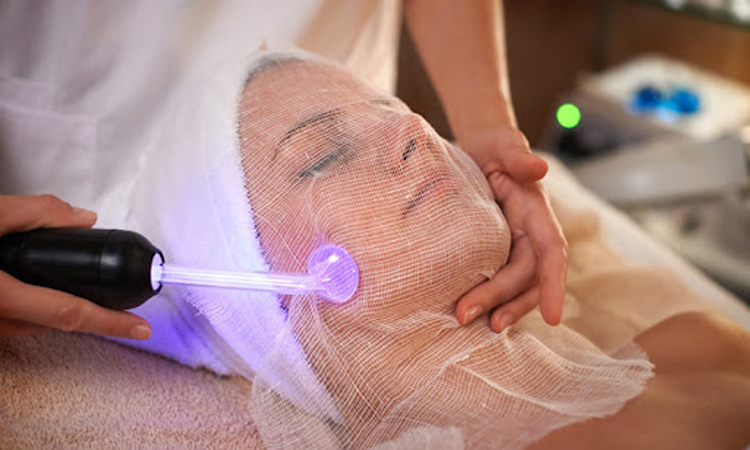A high-frequency facial is a skincare treatment used by professionals to help with acne, wrinkles, enlarged pores, and other skin issues. It uses a high-frequency machine that sends electrical currents to the skin, promoting healing and rejuvenation.

Image Source: www.skin-beauty.com
Deciphering High Frequency Facials
High-frequency facials are a popular skincare treatment option, but what exactly are they? Let’s break it down to see how they work and what they can do for your skin.
How Does High Frequency Facial Work?
A high-frequency facial uses a machine with a glass electrode. The esthetician applies the electrode to your skin, sending a mild electrical current through it. This current creates enriched oxygen molecules on the skin’s surface. The oxygen can kill certain bacteria and reduce inflammation. There are two main methods, direct and indirect.
- Direct High Frequency: The electrode is applied directly to the skin. This method is best for treating acne and other skin issues.
- Indirect High Frequency: The client holds an electrode, and the esthetician massages the skin. This method is better for relaxation and improving circulation.
What Is a High Frequency Facial Machine?
A high-frequency facial machine is a device that generates a high-frequency electrical current. The machine has a handle with different glass electrodes that attach to it. Each electrode is designed for a specific area of the face or body. Common electrodes include:
- Mushroom Electrode: Used for larger areas like the forehead and cheeks.
- Spoon Electrode: Used for sensitive areas like under the eyes.
- Pointed Electrode: Used for spot treatments on acne or blemishes.
- Comb Electrode: Used for the scalp to stimulate hair growth.
The machine allows the esthetician to control the intensity of the current, adjusting it to the client’s skin type and needs.
Unveiling High Frequency Facial Benefits
What are the high frequency facial benefits? High-frequency facials provide a range of benefits, making them a popular choice for those seeking to improve their skin’s appearance and health.
High Frequency Facial Acne
One of the main benefits of high-frequency facials is their ability to fight acne. High frequency facial acne treatments work by:
- Killing Bacteria: The electrical current produces ozone, which has antibacterial properties. This helps kill the bacteria that cause acne.
- Reducing Inflammation: The treatment reduces inflammation, which can help calm existing breakouts.
- Preventing Future Breakouts: By killing bacteria and reducing inflammation, high-frequency facials can help prevent future acne breakouts.
High Frequency Facial Wrinkles
While high-frequency facials are often used for acne, they can also help reduce the appearance of wrinkles. High frequency facial wrinkles treatments work by:
- Stimulating Collagen Production: The electrical current stimulates collagen production, which helps to plump the skin and reduce the appearance of wrinkles.
- Improving Circulation: The treatment improves circulation, bringing more nutrients to the skin and promoting a healthier complexion.
- Tightening Skin: The high-frequency current can help tighten the skin, making wrinkles less noticeable.
Other Benefits
Beyond acne and wrinkles, high-frequency facials offer several other benefits:
- Reducing Enlarged Pores: The treatment can help shrink enlarged pores, making the skin look smoother.
- Reducing Blackheads and Whiteheads: By killing bacteria and reducing inflammation, high-frequency facials can help clear blackheads and whiteheads.
- Improving Skin Tone: The treatment can improve overall skin tone and texture, leaving the skin looking brighter and more radiant.
- Reducing Dark Circles: Some people find that high-frequency facials can help reduce the appearance of dark circles under the eyes.
- Promoting Hair Growth: When used on the scalp, high-frequency treatments can stimulate hair follicles and promote hair growth.
High Frequency Facial Before and After
Many people see noticeable improvements after a series of high-frequency facial treatments. High frequency facial before and after photos often show:
- Reduced acne and blemishes
- Smoother skin texture
- Smaller pores
- Reduced wrinkles and fine lines
- Brighter, more even skin tone
The results can vary depending on the person’s skin type, the severity of their skin issues, and the number of treatments they receive.
Evaluating High Frequency Facial Side Effects and Contraindications
While high-frequency facials are generally safe, it’s important to be aware of potential side effects and contraindications. Understanding the high frequency facial side effects and high frequency facial contraindications will help you determine if this treatment is right for you.
High Frequency Facial Side Effects
Most people experience no or minimal side effects from high-frequency facials. However, some potential side effects include:
- Mild Redness: The skin may be slightly red immediately after treatment, but this usually fades within a few hours.
- Dryness: The treatment can sometimes dry out the skin, so it’s important to moisturize well afterward.
- Tingling Sensation: Some people may feel a slight tingling sensation during the treatment.
- Rare Side Effects: In rare cases, some people may experience a mild allergic reaction or skin irritation.
High Frequency Facial Contraindications
Certain conditions may make high-frequency facials unsafe. High frequency facial contraindications include:
- Pregnancy: High-frequency treatments are not recommended during pregnancy.
- Pacemakers or Other Implanted Devices: People with pacemakers or other implanted electronic devices should not undergo high-frequency facials.
- Metal Implants: The treatment should be avoided in areas with metal implants.
- Epilepsy: People with epilepsy should avoid high-frequency treatments.
- Broken Skin: The treatment should not be performed on areas with broken skin or open wounds.
- Rosacea: High-frequency treatments can sometimes worsen rosacea.
- Migraines: Prone to Migraines
It’s important to discuss your medical history with your esthetician before undergoing a high-frequency facial to ensure it’s safe for you.
High Frequency Facial at Home
While professional high-frequency facials offer the best results, high frequency facial at home machines are available for personal use.
Benefits of At-Home High Frequency
- Convenience: At-home devices allow you to perform treatments in the comfort of your own home.
- Cost-Effective: At-home devices can be more affordable than professional treatments in the long run.
Risks of At-Home High Frequency
- Lower Power: At-home devices typically have lower power than professional machines, so the results may not be as dramatic.
- Improper Use: Using the device incorrectly can lead to skin irritation or other problems.
- Lack of Expertise: Without the guidance of a professional, it can be difficult to determine the right settings and techniques for your skin type.
If you choose to use an at-home high-frequency device, be sure to follow the instructions carefully and start with a low setting to avoid irritating your skin.
The Role of the Esthetician
When seeking a professional high-frequency facial, the expertise of the esthetician is essential. An esthetician high frequency facial experience involves:
Consultation
The esthetician will assess your skin type and concerns, and discuss your medical history to determine if a high-frequency facial is right for you.
Treatment
The esthetician will cleanse your skin and apply a gel or serum to help conduct the electrical current. They will then use the high-frequency machine to treat your skin, adjusting the intensity and technique as needed.
Post-Treatment Care
The esthetician will provide instructions on how to care for your skin after the treatment, including moisturizing and avoiding sun exposure.
Follow-Up
The esthetician may recommend a series of treatments to achieve the best results, and will monitor your skin’s progress to ensure you’re not experiencing any adverse effects.
Frequently Asked Questions (FAQ)
-
How often should I get a high-frequency facial?
The frequency of treatments depends on your skin type and concerns. Typically, a series of 6-10 treatments, spaced one to two weeks apart, is recommended for optimal results.
* Is a high-frequency facial painful?Most people describe the sensation as a mild tingling or buzzing. The intensity can be adjusted to your comfort level.
* Can I wear makeup after a high-frequency facial?It’s best to avoid wearing makeup for at least a few hours after the treatment to allow your skin to breathe and recover.
* How do I prepare for a high-frequency facial?Avoid using harsh skincare products, such as exfoliants or retinoids, for a few days before the treatment. Arrive with clean skin, free of makeup and lotions.
* Is high frequency facial safe for all skin types?High-frequency facials are generally safe for most skin types, but it’s important to discuss your skin type and concerns with your esthetician before undergoing treatment.
* Are there any alternatives to high-frequency facials?Yes, depending on your skincare goals, alternatives might include chemical peels, microdermabrasion, LED light therapy, or topical treatments. Discuss with a skincare professional to determine the best option for you.

I’m Carrie Kelly, the creator behind Gotham Beauty Lounge. Beauty is my passion, and I’ve made it my mission to bring you all the latest trends, expert tips, and honest reviews to help you elevate your beauty game. With a love for all things bold, edgy, and elegant, I believe makeup is an art form, and skincare is self-care. On my blog, I share my personal experiences, favorite products, and advice for embracing your unique beauty. Join me on this exciting journey to feel confident, empowered, and, most importantly, to always look and feel your best!
